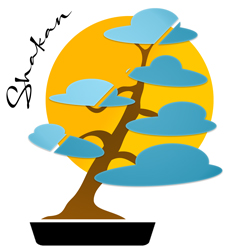Shakan Style: The Slanting Trunk Bonsai
Definition and Origins

The Shakan style, or "slanting trunk style," is a form of bonsai where the tree is intentionally cultivated with a trunk that inclines at a significant angle from the vertical. This style evokes the image of trees facing challenging environmental conditions such as strong winds or steep slopes, forcing them to grow at an oblique angle.
Distinctive Characteristics
- Obliquely Inclined Trunk: The most characteristic trait of the Shakan style is its inclined trunk, which can vary from slightly to strongly inclined, but always with a clear and controlled intention.
- Balance and Stability: Despite the inclination of the trunk, the tree must maintain visual and physical balance, with solid rooting to prevent it from toppling over.
- Adaptive Branching: The branches are arranged to counterbalance the trunk's inclination, often more developed on the side opposite the inclination to maintain balance.
- Crown Aligned with the Base: The tree's crown is generally aligned with the base of the trunk, even if the trunk itself is inclined, for a harmonious aesthetic effect.
- Pot and Presentation: The pot chosen for a Shakan bonsai is often wider on one side to support the angle of the trunk and contribute to the overall balance of the composition.
Species Selection
Species with flexible and resilient trunks are preferred for the Shakan style. Pines, junipers, and certain types of hardwoods like maples are commonly used in this style.
Maintenance and Cultivation Techniques
- Pruning and Pinching: Pruning is essential to control growth and maintain the visual balance of the tree, especially for the branches on the inclined side.
- Wiring: Wiring can be used to direct the trunk and branches into the desired slanted position.
- Repotting and Substrate: A well-draining substrate is crucial, as are regular repottings to maintain the health and stability of the tree.
Conclusion
The Shakan style is a captivating manifestation of adaptation and resilience in the art of bonsai. It symbolizes the struggle of trees against environmental challenges, while offering a natural and dynamic aesthetic that stimulates the eye and the imagination.

















